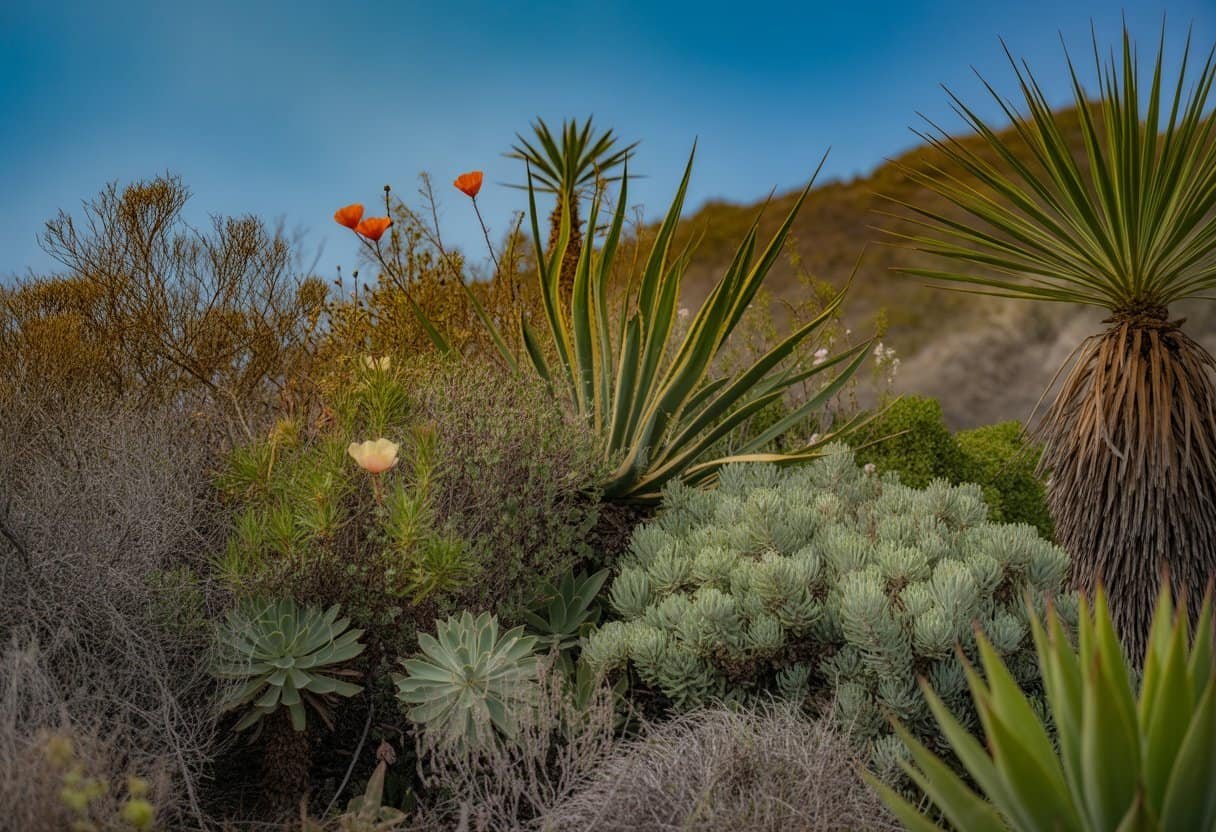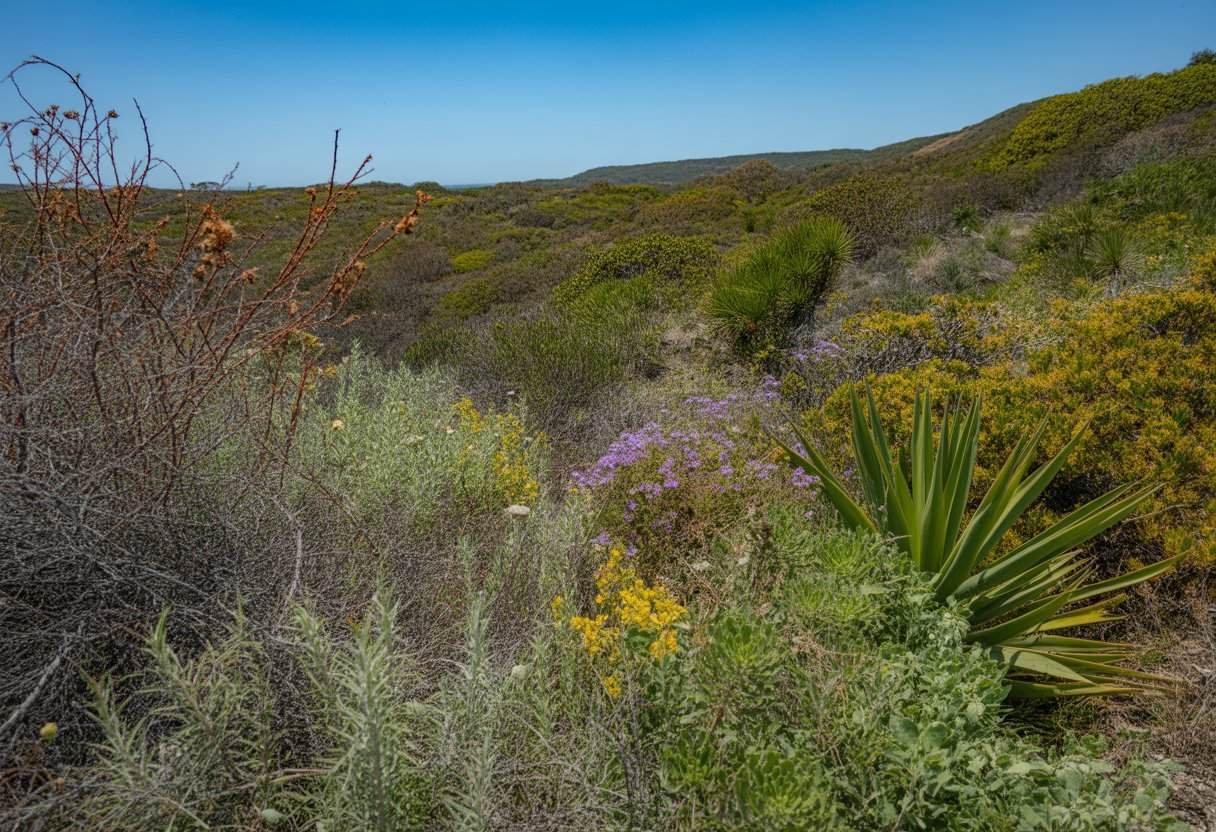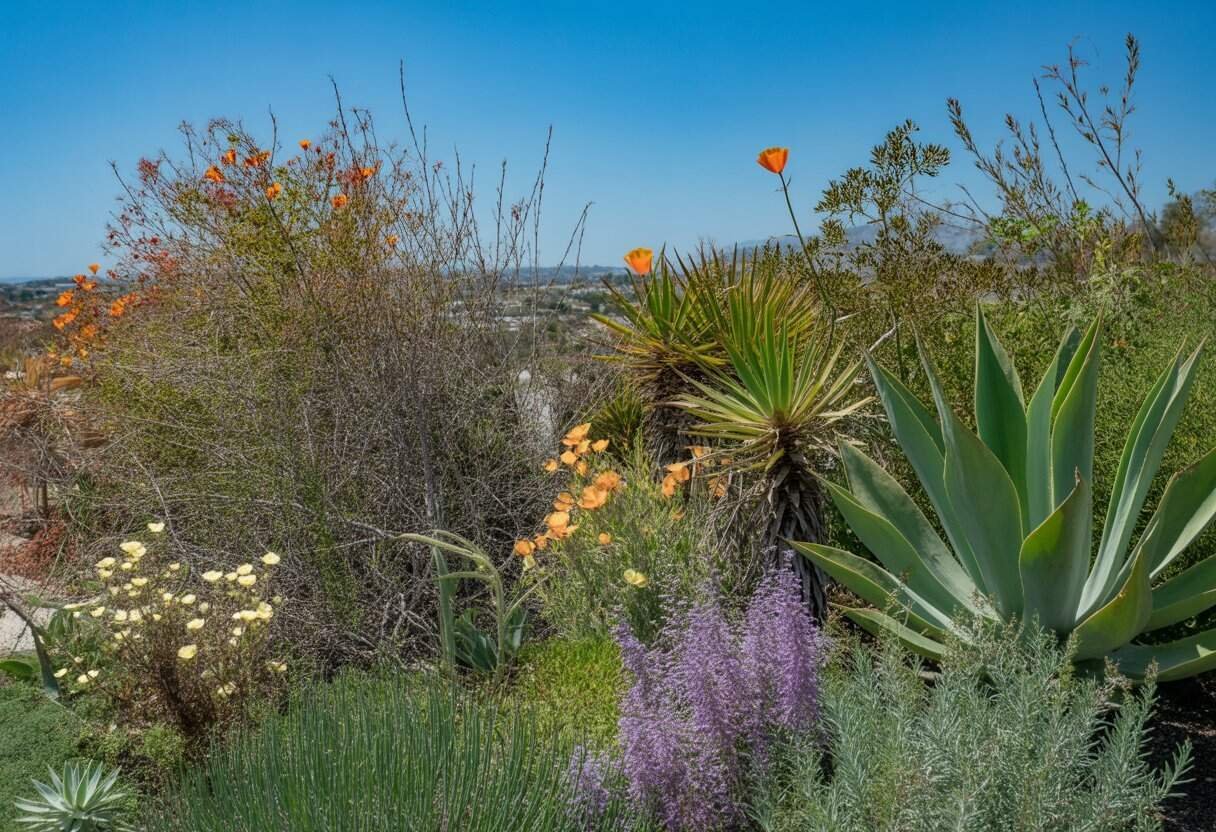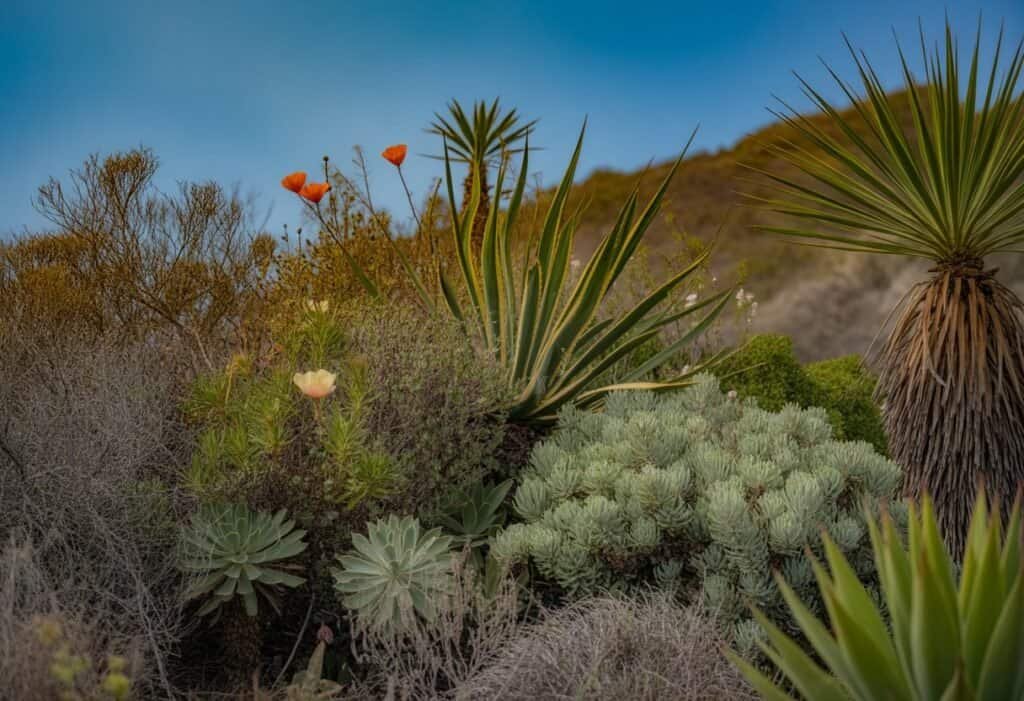San Diego native plants bring beauty and sustainability to local gardens. These plants have adapted to our region’s unique climate over thousands of years.
They thrive with minimal water and maintenance. Growing native plants helps conserve water, support local wildlife, and preserve San Diego’s natural heritage.

Our region boasts an incredible diversity of native species, from colorful California poppies to majestic coast live oaks. Many homeowners are discovering that native gardens offer a practical alternative to traditional lawns.
These plants have evolved to handle our dry summers and mild, wet winters without extra help. Native plants create habitat for local birds, butterflies, and bees that depend on these specific species for survival.
They connect us to the natural history of our region in ways that imported plants cannot match.
Key Takeaways
- Native plants require less water and maintenance while supporting local wildlife and ecosystems.
- San Diego’s Mediterranean climate supports diverse native species adapted to thrive in local conditions.
- Creating a native garden helps preserve biodiversity and connects homeowners to the region’s natural heritage.
What Are San Diego Native Plants?
San Diego native plants evolved in the local region over thousands of years. They have adapted perfectly to the Mediterranean climate and unique soil conditions.
These plants require minimal maintenance and provide essential habitat for local wildlife.
Defining Native Plants
Native plants are species that evolved naturally in a specific region without human introduction. In San Diego, native plants developed over thousands of years, perfectly adapted to the local climate, soil, and ecological conditions.
These plants grew in Southern California before European settlement. They form part of the complex local ecosystem.
They have co-evolved with native animals, fungi, and microorganisms to create balanced biological communities. Native plants in San Diego include iconic species like the Coast Live Oak, California Sagebrush, and Cleveland Sage.
These plants represent the true natural heritage of the region. They play vital roles in maintaining local biodiversity.
Common Characteristics of San Diego Natives
San Diego native plants share several key adaptations to the region’s Mediterranean climate.
Drought Tolerance: Most native plants have:
- Deep root systems to access groundwater
- Small, leathery leaves to reduce water loss
- Dormancy periods during extreme heat
Fire Adaptation: Many species evolved with periodic wildfires and can:
- Resprout from underground roots after fires
- Produce seeds that require heat to germinate
Most San Diego natives thrive with minimal water once established. They typically need little maintenance, fertilizer, or pest control.
Many feature silvery or gray-green foliage that reflects sunlight. This reduces water loss during hot periods.
Comparison with Non-Native Species
Native plants offer significant advantages over non-native alternatives in San Diego landscapes.
| Characteristic | Native Plants | Non-Native Plants |
|---|---|---|
| Water needs | Low to very low | Often moderate to high |
| Maintenance | Minimal | Frequently extensive |
| Wildlife value | High | Limited or none |
| Disease resistance | Strong | Often susceptible |
Non-native plants can become invasive and crowd out indigenous species. They often disrupt ecosystems.
They typically lack natural controls like insects or diseases that would limit their spread in their home regions. Native plants support local biodiversity by providing food and habitat for native insects, birds, and other wildlife.
Research shows yards with native plants support up to 8 times more biodiversity than those with non-natives.
San Diego’s Natural Environment and Habitat

San Diego’s unique landscape supports a diverse array of native plants. These plants have evolved to thrive in specific conditions.
They form distinct communities that contribute to the region’s ecological richness and natural beauty.
Mediterranean Climate and Plant Adaptations
San Diego experiences a Mediterranean climate with mild, wet winters and warm, dry summers. Annual rainfall averages just 10-12 inches, mostly falling between November and March.
This climate pattern has shaped how local plants survive. Native plants have developed remarkable adaptations to withstand the long dry season.
Many feature small, leathery leaves that reduce water loss through transpiration. Others have deep root systems to access underground moisture.
Some plants, like California poppy, go dormant during dry periods. Several adaptations help plants manage fire risk:
- Thick bark for protection
- Ability to resprout from roots after burning
- Heat-activated seed germination
- Flammable oils that promote fast-moving fires
Key Plant Communities and Ecosystems
San Diego County hosts several distinct plant communities. Each community supports unique collections of species.
Coastal Sage Scrub occupies lower elevations near the coast. This community features aromatic, drought-deciduous shrubs like California sagebrush and black sage.
Many endangered species depend on this rapidly disappearing habitat. Oak Woodlands appear in foothill areas with coast live oak serving as the dominant tree.
These majestic trees provide food and shelter for numerous wildlife species. Riparian Areas follow streams and rivers, supporting water-loving plants like willows and sycamores.
These green corridors provide critical wildlife habitat and help filter water. Wetlands and Salt Marshes occur along the coast, hosting specialized plants that tolerate saltwater influence.
Role of Chaparral in Local Biodiversity
Chaparral dominates much of San Diego’s landscape and covers hillsides with dense, woody shrubs. This tough plant community thrives in the region’s hot, dry conditions.
Chaparral plants like manzanita, chamise, and ceanothus create a tight-knit ecosystem that protects soil from erosion. Their extensive root systems help stabilize slopes and prevent landslides during heavy rains.
Fire plays a crucial role in chaparral ecology. Many chaparral species require fire to reproduce, with seeds germinating only after exposure to smoke or heat.
This plant community supports numerous wildlife species. Birds nest in dense foliage, while mammals find shelter among the shrubs.
Many insects depend on chaparral plants, creating a complex food web.
Benefits of Growing Native Plants

San Diego native plants offer tremendous advantages for your garden and the environment. These plants have adapted to our local conditions over thousands of years.
They make perfect choices for sustainable landscaping.
Supporting Local Biodiversity
Native plants form the foundation of San Diego’s ecosystem. They have evolved alongside local insects, birds, and other wildlife, creating intricate relationships that support biodiversity.
When you plant natives like California sagebrush or Cleveland sage, you preserve genetic diversity that has developed specifically for our region. This genetic diversity helps plant communities adapt to changing conditions and resist diseases.
Native plant gardens create stepping stones between natural areas, allowing species to move through urban environments. This connectivity is crucial as climate change forces species to shift their ranges.
Research shows that native plant gardens support 3-4 times more insect and bird species than non-native landscapes.
Wildlife Habitat for Butterflies and Hummingbirds
San Diego native plants provide essential food and shelter for local wildlife. Butterflies depend on specific native plants for their entire life cycle.
Monarch butterflies lay eggs exclusively on milkweed plants (Asclepias fascicularis). The caterpillars can only eat milkweed leaves to survive.
By planting milkweed, you directly support monarch populations. Hummingbirds thrive on nectar-rich natives like:
- California fuchsia (Epilobium canum)
- Cleveland sage (Salvia clevelandii)
- Desert mallow (Sphaeralcea ambigua)
These plants produce the high-energy nectar hummingbirds need. Their tubular flowers evolved specifically for hummingbird pollination.
Native plants also host the insects that birds need to feed their young. A single chickadee family needs 6,000-9,000 caterpillars to raise one brood of nestlings!
Water Conservation Advantages
Native plants dramatically reduce water usage in the landscape. They’ve adapted to San Diego’s Mediterranean climate with its dry summers and occasional drought years.
Once established, many natives need little to no supplemental irrigation. Plants like white sage (Salvia apiana) and lemonade berry (Rhus integrifolia) can thrive on natural rainfall alone.
This adaptation can cut landscape water use by 50-75% compared to conventional gardens. Deep root systems help native plants access groundwater and resist drought.
These roots also improve soil structure and reduce erosion during heavy rains. Native plant gardens eliminate the need for chemical fertilizers and pesticides that contaminate water supplies.
Their natural adaptations to local soils and pests create a self-sustaining landscape that protects water quality.
As climate change brings more extreme weather, water-wise native gardens become increasingly valuable for conservation.
Popular San Diego Native Plants
San Diego’s landscape thrives with beautiful native plants that have adapted to the region’s Mediterranean climate. These plants require minimal water once established and provide essential habitat for local wildlife.
Salvia Species
Salvia clevelandii (Cleveland Sage) stands out among San Diego’s native plants with its aromatic gray-green foliage and whorls of blue-purple flowers. This drought-tolerant shrub grows 3-5 feet tall and attracts numerous pollinators during its spring and summer bloom season.
Salvia spathacea (Hummingbird Sage) features large, fuzzy leaves and magenta flower spikes that emerge in early spring. It performs well in partial shade and serves as a favorite nectar source for hummingbirds.
Salvia apiana (White Sage) has distinctive silvery-white leaves and tall flower stalks reaching 3-5 feet. Indigenous peoples have traditionally used this plant for ceremonial purposes.
It requires full sun and excellent drainage to thrive. These salvias need minimal irrigation once established and perform best with good air circulation.
California Fuchsia
Epilobium canum (California Fuchsia) displays striking trumpet-shaped orange-red flowers from late summer through fall. This low-growing perennial reaches about 1-2 feet tall and spreads via underground rhizomes.
California Fuchsia’s vibrant blooms appear when many other plants have finished flowering. It provides crucial late-season nectar for hummingbirds preparing for migration.
Several cultivars offer variety in height and flower color, from ‘Catalina’ with its compact form to ‘Everett’s Choice’ with its silvery foliage. This plant thrives in poor soils and requires excellent drainage.
Once established, it needs very little water and performs best with a hard pruning in late winter to encourage fresh growth and abundant blooms.
Other Iconic Native Genera
Ceanothus (California Lilac) varieties like ‘Concha’ and ‘Ray Hartman’ offer spectacular blue flower displays in spring. These evergreen shrubs range from ground covers to small trees, providing year-round structure in native gardens.
Arctostaphylos (Manzanita) species feature distinctive red bark, leathery leaves, and delicate urn-shaped flowers. A. ‘Howard McMinn’ and A. ‘Sunset’ perform particularly well in San Diego gardens and require minimal water once established.
Encelia californica (California Sunflower) brightens coastal areas with golden daisy-like blooms on 3-4 foot shrubs. It attracts butterflies and beneficial insects.
Romneya coulteri (Matilija Poppy), often called the “fried egg plant,” produces enormous white flowers with yellow centers on 6-8 foot stalks. It creates a dramatic focal point in larger gardens.
Designing a Native Garden in San Diego
Creating a native garden in San Diego brings beauty and sustainability to your landscape. Native plants thrive with minimal water and maintenance while supporting local wildlife and preserving the region’s natural character.
Site Selection and Preparation
Choose a site that gets enough sunlight for your plants. Most San Diego natives need full sun, but some tolerate partial shade.
Remove all non-native plants and weeds before planting. This helps native plants establish themselves.
Test your soil drainage by digging a hole, filling it with water, and watching how fast it drains. Most native plants grow best in well-draining soil.
Heavy clay soils may need sand or gravel to improve drainage. Good drainage prevents root rot.
Look at your garden’s topography. Build berms or shallow depressions to direct rainwater where you want it.
This setup mimics natural water flow and lowers the need for irrigation. It also helps prevent water runoff.
Avoid adding too much soil amendment. Native plants adapt to local soil and usually do better without rich additives.
Planting Plans for Year-Round Color
Create a planting strategy that offers color in every season. Mix plants with different bloom times for year-round interest.
Spring Bloomers:
- California poppy (Eschscholzia californica)
- Cleveland sage (Salvia clevelandii)
- Island snapdragon (Gambelia speciosa)
Summer and Fall Color:
- Buckwheat (Eriogonum species)
- Manzanita (Arctostaphylos species)
- San Diego sunflower (Bahiopsis laciniata)
Group plants with similar water needs together using hydrozoning. This keeps drought-tolerant plants from getting too much water.
Plan for plant height and spread at maturity. Place taller plants in the back and shorter ones in front for better visibility.
Attracting Pollinators and Wildlife
Native gardens attract local wildlife. Different plant shapes support many species and create a healthy ecosystem.
Plant butterfly host plants like milkweed (Asclepias fascicularis) for Monarchs. Add California buckwheat and sages for nectar.
Tubular flowers like California fuchsia (Epilobium canum) and monkeyflowers (Diplacus species) attract hummingbirds. These blooms give birds the energy they need.
Leave some leaf litter and dead branches as shelter for helpful insects. These insects help control pests.
Add a small water feature or bird bath. Even a shallow dish with water attracts birds and pollinators during dry spells.
Waterwise Landscaping Techniques
San Diego’s climate requires smart water use in gardens. Native plants and good landscaping can reduce water use and create beautiful, sustainable spaces.
Principles of Xeriscaping
Xeriscaping works well in dry regions like San Diego. This method saves water through seven main steps: planning, soil improvement, efficient irrigation, grouping plants by water needs, mulching, limiting turf, and proper care.
Prepare soil well to help native plants grow strong roots. Add compost to clay soils for drainage or to sandy soils to hold water.
Group plants with similar water needs (hydrozoning) to avoid overwatering. Keep thirsty plants together and separate from drought-tolerant ones.
Use mulch in xeriscaped gardens. Spread 2-3 inches of mulch around plants to hold moisture, block weeds, and keep soil cool.
Organic mulch like wood chips also improves soil as it breaks down.
Selecting Drought-Tolerant Natives
San Diego offers many drought-resistant native plants that need little water. Try these reliable choices:
Shrubs and Perennials:
- Cleveland sage (Salvia clevelandii)
- California buckwheat (Eriogonum fasciculatum)
- California lilac (Ceanothus species)
- Manzanita (Arctostaphylos species)
Ground Covers:
- Beach strawberry (Fragaria chiloensis)
- Coyote brush (Baccharis pilularis)
Water native plants regularly for 1-2 years to help them grow deep roots. After that, most natives need little or no extra water.
Pick plants native to your area in San Diego County. Coastal natives may not do well inland, and desert natives thrive in hotter areas.
Irrigation Strategies for Native Gardens
Watering efficiently is important, even with drought-tolerant plants. Drip irrigation sends water straight to roots, cutting waste from evaporation and runoff.
This system can save 30-50% more water than sprinklers. Install a smart controller that changes watering based on the weather.
These systems lower water use by 15-30% compared to regular timers. Water deeply but not often to help roots grow deep.
Most established native plants do best with occasional deep watering. Water in the morning before 10 AM to reduce evaporation and disease.
Avoid watering on windy days, as water won’t reach plants evenly. Check your irrigation system each month for leaks or clogs.
Adjust watering schedules with the seasons—water less in winter and carefully increase during summer heat.
Climate Change and the Future of San Diego Native Plants
San Diego’s native plants face new challenges as the climate changes. These plants must adjust to warmer temperatures and less predictable rainfall.
Challenges Facing Native Plant Habitats
Climate change affects San Diego’s environment in many ways. Average temperatures have risen by 2-3°F since the early 1900s.
There are more days of extreme heat each year. Rainfall is less predictable, with long droughts and heavy rain events.
Native plants struggle with these changes. More frequent and intense wildfires also make recovery harder for native species.
Rising sea levels threaten coastal habitats like sage scrub and salt marsh. These unique places may disappear as the coastline changes.
Non-native invasive species often outcompete natives in disturbed areas. Climate stress makes native plants more vulnerable.
Resilience and Adaptation Strategies
Some native plants show strong resilience to change. Desert-adapted species like California buckwheat and white sage handle heat and drought well.
Conservation groups identify and protect “climate refugia”—cooler, moister spots where native plants may survive. These include north-facing slopes and canyon bottoms.
Wildlife corridors help plants spread seeds to new areas. Assisted migration means people help move plants to better locations by collecting and planting seeds where conditions may improve.
Home gardeners help by:
- Growing native plant gardens as mini-refuges
- Collecting and sharing seeds from successful plants
- Using less water with native landscaping
Researchers track genetic diversity in native plants to find traits that help them adapt.
Frequently Asked Questions
San Diego’s climate supports many native plants that need little care and water. These plants have adapted to local conditions over thousands of years.
What are some common native plants suitable for landscaping in San Diego?
California Lilac (Ceanothus) grows well in San Diego and has blue flowers. This shrub needs little care after it’s established.
Cleveland Sage (Salvia clevelandii) has aromatic gray-green leaves and purple-blue flowers that attract pollinators. It likes full sun and well-drained soil.
Toyon (Heteromeles arbutifolia) is a shrub that can reach 15 feet and has red berries in winter. Birds love the berries.
Manzanita varieties like Howard McMinn (Arctostaphylos) have red bark, bell-shaped flowers, and evergreen leaves. They need good drainage and little summer water.
How can I identify San Diego native plants?
Leaf shape and texture help with identification. Many natives have small, tough leaves to save water.
Growth patterns also help. California sagebrush has a unique form and a strong scent.
The Calflora website and iNaturalist app let you search plant databases and upload photos for help. These tools use location data for San Diego County.
Field guides from the San Diego Natural History Museum focus on local species. They include photos and identification keys.
Which native plants in San Diego are known to attract butterflies?
Narrow-leaf Milkweed (Asclepias fascicularis) is the host plant for Monarch butterflies. Monarch caterpillars feed only on milkweed.
California Buckwheat (Eriogonum fasciculatum) attracts many butterfly species with its small white to pink flowers. It blooms from spring through fall.
Bush Sunflower (Encelia californica) gives nectar to butterflies and seeds to birds. Its yellow flowers brighten gardens from winter through spring.
Desert Mallow (Sphaeralcea ambigua) has orange flowers that attract Painted Lady butterflies. It grows in poor soil and needs little water.
Where can I find a nursery that specializes in San Diego native plant species?
Tree of Life Nursery in San Juan Capistrano offers a large selection of California natives. They sell plants chosen for Southern California gardens.
Las Pilitas Nursery gives detailed growing advice with their plants. Their website has care instructions for each species.
The San Diego Chapter of the California Native Plant Society holds seasonal plant sales. These events offer rare species and advice from experts.
Walter Andersen Nursery and Moosa Creek Nursery both have sections for local native plants. They offer plants suited to different microclimates in the county.
What are the best native trees to plant in San Diego’s climate?
Coast Live Oak (Quercus agrifolia) provides shade and supports over 300 wildlife species. This evergreen oak can live for centuries with little care.
Western Redbud (Cercis occidentalis) brings spring color with magenta flowers before its heart-shaped leaves appear. It grows up to 20 feet tall.
California Sycamore (Platanus racemosa) grows near seasonal water and has mottled bark and large leaves. It’s an attractive landscape tree.
Desert Willow (Chilopsis linearis) has tubular pink to purple flowers that attract hummingbirds. This drought-tolerant tree grows well in inland San Diego.
How does the San Diego Native Plant Society contribute to conservation efforts?
The Society conducts regular surveys of rare plant populations throughout the county. These surveys track changes in distribution and abundance over time.
Trained volunteers lead restoration projects to reestablish native plants in degraded areas. These projects create habitat for wildlife and improve ecosystem health.
Educational programs raise awareness about the importance of native plants. Monthly meetings, field trips, and workshops teach people how to identify and care for native plants.
The Society advocates for land preservation and sensible development policies. Their input shapes conservation plans that protect San Diego’s unique plant communities.


